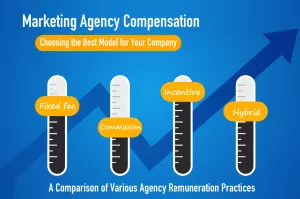Introduction
Enterprises, large and small, are all taking a hard look at the marketing agency agreements under which they are currently working. The days of 15 percent media commissions are long gone; the “Mad Men” era is in the rear view mirror.
A variety of agency compensation models are being used today, ranging from fees to licensing of IP products that the agency produces on the client's behalf, and several options in between. There is no magic formula, as each situation will dictate what is best for the client.
The advertiser needs to acknowledge that the agency is in business to generate profits, and should be compensated fairly. Don't overpay, but don't squeeze to the point that the agency will not commit the resources necessary to create great work on your behalf. The idea is to determine just what is “fair” and create a win-win situation for both the agency and the advertiser.
Marketers today are demanding more value from their agencies in terms of services provided. How to recognize and measure these contributions, and compensate accordingly, is open for analysis.
According to Marketing Math, “The key to crafting a proper remuneration package comes down to one item — measurement.”1 For this to work best, the advertiser should tie agency compensation to its deliverables. The company's business performance should also be a metric used in calculating compensation.
There seems to exist a dichotomy between what the agencies want to achieve financially and what the advertisers want them to deliver. The clients appear to only want more scope of work for less money, which is not true. The agencies, on the other hand, have to manage the profit demands of their holding company, increased talent costs, and the complexities of the rapidly changing online media environment. All of which puts them in a fix.
The profit margin, however, is very much a point of contention. According to an Adweek article dated Aug. 21, 2013, agencies are looking for a 17 percent margin and advertisers believe they should be making a 14 percent profit margin.2 This difference often leads to pointed negotiations between the two parties.
Growth in Procurement's Involvement
Fee-based compensation continues to be the preferred remuneration model for agencies. According to a study released by the Association of National Advertisers (ANA) in 2013, 81 percent of compensation agreements were fee-based.3 The study also showed that 82 percent of the companies participating in the survey had their procurement teams involved in structuring agency compensation.
The Bedford Group, in its paper titled “Advertising Agency Compensation in an ROI Driven World”, highlights the increased involvement of the procurement department in these negotiations.4 According to the group, “This involvement creates new negotiation and communication challenges for professional service providers. What was (or seemed to be) the last bastion of corporate governance — marketing spend — has now become the 'hotbed 'of negotiating rituals and guidelines never seen before between marketers and their agencies.” This comment demonstrates how significant a role procurement can play in getting the best service delivery from the agency at the most appropriate cost for the client.
The American Association of Advertising Agencies (4A's), in a recent paper, acknowledged that due to the continued involvement of procurement departments in the compensation agreement negotiations “... it is likely that these professional buyers are well schooled in the strategies and tactics of negotiation.”5 This is a real plus for the advertisers. The involvement of procurement teams has helped in the development of value-based compensation models, as they are trained to apply success metrics to all company expenditures.
But, as the negotiation stage of the agreement is reached, marketing also needs to be a part of the process. Marketing and procurement can complement each other during the negotiation process and set the right expectations from the agency.
No Off-the-Shelf Approach
While developing a compensation program, clients must create one that is closely aligned with their particular business needs and not the agency's standard agreement. The ANA study of more than 300 member agreements showed that no two agency agreements were alike. There cannot be a cookie-cutter approach to this issue.
At the same time, there has been a significant growth in risk-reward scenarios, where the agency risks a reduction in income if it underperforms, and receives a bonus for exceeding goals. This can be a win-win for clients. The agency will now be judged on the basis of agreed-upon metrics, and will be paid based on its performance.
1. Marketing Math, Nov. 14, 2013, http://marketingmath.aarmusa.com/2013/11/14/what-is-the-right-approach-t...
2. Adweek, Aug. 21, 2013, http://www.adweek.com/news/advertising-branding/look-how-agency-compensation-has-changed-151921
3. Association of National Advertisers, Trends in Agency Compensation Survey, 2013
4. Bedford Group, http://bedfordgroupconsulting.com/marketing-insights/advertising-agency-compensation-in-a-roi-driven-world/
5. American Association of Advertising Agencies, Agency Compensation: 4A's Agency Compensation Transformation Doctrine — Strategic Pillars
Compensation Models
Agencies deal in billable hours, like many professional service companies. These hourly costs take into account salaries, benefits, overhead, etc. Agencies calculate that to break even, they need to bill their people's time at 250 percent of salary (source: Frankfurt Kurnit Klein & Selz). The agency profit is added to this number. How these costs are packaged in the agreement is the essence of the contract.
Monthly Retainer or Fixed Fee
Retainers are paid monthly and are usually agreed upon for one year. The retainer is calculated by the agency based on the agreed scope of work, and is calculated on an estimate of man-hours and staffing needs on an ongoing basis. The estimate is largely based on past experience with the same client or similar-sized clients. It can also include the value of the work to the client, spending level, budget available, level of agency involvement, etc.
A retainer model enables the client to manage their monthly budgets more easily, and provides the client with a clear view of savings versus expenses per project. However, if marketing spend is reduced due to unforeseen business reasons, the monthly retainer fee may exceed the actual work produced by the agency, and would have to be adjusted. Also, the retainer model lacks the agency accountability available with other methods of compensation.
The fee charged is based on the number of agency employees dedicated to the client's business, the anticipated number of hours those employees will spend on the client's business, and the agency's markup. Advertisers should benchmark these costs against other agency charges for similar employees, i.e., man-hour costs for account directors, creative directors, etc. Organizations such as the ANA, if the advertiser is a member, can be of good help here. Also, if the advertiser belongs to a trade association(s), it can contact others within the group and find out how much they are paying their agencies for similar work. In this way, the advertiser can better negotiate with the agency.
Commissions
Commissions were the tried and tested method for agency compensation for almost a hundred years. Agencies would create advertising — TV commercials, radio commercials, magazine and newspaper ads — and then buy the media necessary to place this work. They would get 15 percent commission on all media purchased, plus the same net commission on the production of all the ads.
In the 1970s, “media buying services” emerged, who proposed a new paradigm to advertisers: “Why pay your agency 15 percent on all media purchases when we will do the same thing for you for five percent, or a lot less eventually?” This completely reopened the question of how agencies were to be compensated by their clients. These media buying services presented an argument that was so compelling that, within a few years, advertisers of all sizes hired them for all their media planning and buying.
The advantage of compensating your agency on a commission basis is that the amount paid is totally dependent on the size of your media spend. If budgets are reduced, you pay the agency less. There is no fixed amount or monthly payment due. However, less than 10 percent of advertisers today follow the commission model.
Today, clients are looking to their marketing agencies to provide them with integrated solutions that are platform agnostic. Media commission should not drive recommendations, but it might, if commission is the only way that the agency gets paid.
Agencies prefer commissions, when they can arrange them, because it appears to be “invisible”. That is, there are no actual fee payments to the agency. This helps avoid any internal auditing, bookkeeping or financial review that can raise red flags within the client's organization. Also, being paid on a commission basis frees the agency from an examination of the actual value it provides. Paying an agency on a commission basis is a substitute for determining the appropriate compensation for its services. It is certainly the least accountable method of compensation, and is not recommended for all of the aforementioned reasons.
Project Fees
When a client does not have continuous advertising activity on a 12-month basis, negotiating project fees may prove to be the most appropriate method of compensation. This does not negate having an ongoing relationship with the agency, but frees the company from any monthly fee obligations in those months when marketing activity is dormant. This is not the preferred method for companies that require advertising support throughout the year or have long-term relationships with their agencies.
The project fee model works when the company knows exactly what marketing and communications problems it is looking to solve, and can provide the agency with thorough briefings that lead to solutions that can be accomplished in a timely manner.
This allows the company to manage its cash flow as there is a prescribed payment schedule provided by the agency in the project's scope of work. Also, this method helps the client determine the value of the agency's work, based on output.
However, it is important to bear in mind that the hourly rates charged by the agency for project work are higher than they are in a monthly fee model. The agency has no guaranteed monthly income, so it charges a higher rate per project.
Also, another disadvantage of this method is that the agency does not guarantee that the same employees will work on each project, as they may be assigned to other client work. This leads to duplication of efforts as the client may have to brief the new agency staff again about its brand and business.
Sale or License of IP Products
This is a rarely used compensation method where the client pays for the non-advertising usage of agency ideas or concepts. For example, if the agency develops an innovative advertising concept that the client wants to extend to promotions, special events, sponsorships, or packaging, it will negotiate with the agency on the compensation for these additional usages. This can be viewed as similar to project work, as the client is only paying for the exact implementations of the ideas it chooses to use.
Incentive Compensation
A confluence of various factors has led to rapid increase in growth of the incentive compensation model in agency remuneration agreements. According to the 2013 ANA study referenced earlier, 61 percent of their members use this model. Of course, it is important to remember that ANA members tend to be the largest advertisers, but for directional purposes, this is very useful.
One factor has been the participation of procurement in the contract negotiation process. As reported in the ANA study, 82 percent of their members had procurement involved in the contract negotiation process. According to Bob Liodice, president & CEO of the ANA, “Companies have been increasing their use of the procurement department as a primary vehicle to ensure both expertise and efficiency in evaluating both the agency and agency compensation.”6
6. AdAge, Sep. 16, 2013, http://adage.com/article/btob/fees-remain-leading-form-agency-compensation/290199/
The second factor is the pressure being put on Chief Marketing Officers (CMOs) to have their marketing spend more ROI-driven. In both cases, the goal is to make all elements of the marketing budget accountable for the amount committed by the company.
This includes expenses for media advertising, sales promotion, public relations, events and sponsorships, and the actual fees being paid to the marketing resources hired by the company. The effort is to analyze exactly what “value add” the agency provides, and how can it be measured. Once measured, the client can then tie the actual payments to results.
In a long-term relationship, as the agency gets to know the client's business, and where the levers for success are, it is in a position to make strategic recommendations and be more proactive in servicing the business. These contributions deserve to be rewarded by some sort of bonus structure.
When calculating the incentive compensation for the ad agency, clients should create metrics that are tied to its performance as well as the performance of their company. The old adage “what gets measured, gets done” certainly applies here.
Possible key performance indicators (KPIs) for the calculation of incentive compensation can include:
- Use of an annual Attitude and Awareness Study with agreed upon improvements year-on-year such as:
- Improvement in brand awareness
- Improvement in ad awareness
- Increase in purchase intent
- Increase in direct response rates
- Lead generation rates
- Advertising test scores
- Sales goals for the brand(s) that are in line with the marketing department's goal
- Increase in market share
- Increase in number of customers
- Increase in purchase by existing customers
- Introduction of products/services into new markets
- Formal quantitative evaluations of the agency by key stakeholders in the client company
Some of these metrics may be difficult to analyze, but clients should use all available data, from as many departments as necessary, to measure their agency's performance. Also, clients must recognize that some subjectivity will enter the process and accept it.
In this compensation model, clients must budget a reserve so that they are in a position to pay their agency the incentive, if applicable, without sacrificing any planned marketing activities.
Risk & Reward
This method forces the agency to “put skin in the game”. The agency risks a portion of its total compensation for the potential of realizing a greater reward. It stands to earn compensation beyond what it would be paid under a straight fee basis, but also risks being paid less. If the client has a bad year, and does not achieve its business goals, the agency's bonus could be smaller than projected, or even nonexistent.
Under this model, the agency is required to return a portion of its fee if goals are not achieved. This is generally realized in the form of a credit against the following year's fees, not an actual check from the agency.
According to ANA's 2013 study, 56 percent of their members surveyed were using a risk-reward compensation model. However, in 2010, 65 percent of ANA members were using this model, which means that its adoption is decreasing.
Thinking Outside the Box
Some agencies — usually those that are independent and do not have to answer to their holding company's management — might be willing to explore unorthodox options with clients. These options depend heavily on the success of the client's business and may only allow the agency to break even. For instance, in addition to a nominal fee, the agency can get paid based on:
- The number of (high-end) items sold such as automobiles, vacation packages, jewelry, etc.
- New subscribers/customers added
As Adweek reported in its issue dated May 1, 2006, the compensation model between Haggar and Crispin Porter + Bogusky was based on the agency receiving a minority equity stake in the company. This is definitely not advised for multi-billion dollar public corporations, but illustrates the unconventional thinking that can be applied to an agreement between a client and its agency. The dot-com bubble demonstrated, all too often, the risk by the agency in this scenario. And, in most cases, agencies will not enter into an agreement like this with startups today.
Conclusion
With shrinking budgets and ROI-driven marketing strategies, clients and agencies are increasingly at loggerheads in determining a compensation model that's fair as well as cost-effective, without compromising on performance.
Agencies must be transparent in their pricing and help clients understand what it costs them to deliver what's expected of them. With this knowledge, the client's procurement and marketing department can negotiate a compensation model that works best for their company and still allows the agency to make a fair profit.
As mentioned earlier, there cannot be a one-size-fits-all approach to this issue. To receive the highest level of service, for the most appropriate cost, clients must look at all the business factors in deciding which model to adopt when negotiating with an agency. The goal must be to get the desired value, while paying a fair price to the agency.
Establishing KPI's that must be measured and met will ensure that the agency has a scorecard that will evaluate its contribution to the client's success.
The idea is to set a foundation where cost and price are linked. Both sides need to feel comfortable that this is being done in a manner that's fair and based on trust.



